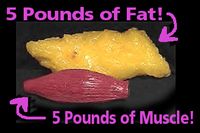| Share |  |
 | |||
Health Gain-Weight Loss - Part 8 - Smarter Ways to Exercise
 The many ways that exercise benefits health are far too numerous to describe within the scope of a single article. There is simply no substitute for exercise in maintaining a healthy weight.
The many ways that exercise benefits health are far too numerous to describe within the scope of a single article. There is simply no substitute for exercise in maintaining a healthy weight.
This is especially true of certain types of exercise that directly impact the speed and efficiency of metabolism by increasing muscle mass and oxygen intake.
In Part Two of this Health Gain-Weight Loss series, we looked at the various ways that calorie-restricted diets, along with not eating often enough, place the body in a self-protective “starvation mode” that cause calories to be stored as fat instead of burned for energy. Changing when and how often you eat helps prevent this tendency of the body to a degree, but dietary measures alone will not boost metabolism sufficiently to keep excess calories from being stored as fat.
The most effective natural way to speed up metabolism is to exercise. We were designed by God to move. Not only do people eat far too much these days (due at least in part to the insufficient amounts of true nutrition in devitalized, processed food), but the sedentary lifestyle of most of us also allows no opportunity for that extra “energy” to be expended. The body has no choice but to store unused energy as fat. Exercise, however, creates an energy deficit that forces the body to burn fat for fuel and prevents the depletion of valuable muscle tissue that results in a slower metabolism.
Build It or Lose It
 Lean muscle tissue is the most critical component of an efficient metabolism. If you remember from Health Gain-Weight Loss – Part Two, each pound of muscle burns three times as many calories as one pound of fat. An extra 40-50 calories are burned to keep just one pound of muscle alive!
Lean muscle tissue is the most critical component of an efficient metabolism. If you remember from Health Gain-Weight Loss – Part Two, each pound of muscle burns three times as many calories as one pound of fat. An extra 40-50 calories are burned to keep just one pound of muscle alive!
The big advantage of increasing lean muscle mass is that it raises the body’s resting metabolism rate (RMR), which means that calories continue to be burned even when the body is inactive. Less muscle, however, translates to a lower metabolic rate, in which fewer calories are burned for energy.
 Besides the decline in muscle mass from sedentary lifestyles, another strike against those of us who are “mature” is that muscle tissue naturally begins to deteriorate after the age of 35. Unless measures are taken to counter this decline in muscle mass, it will be far easier to gain weight and much harder to lose it, even when the same number of calories are consumed. Remember that body fat is only reduced when more calories are burned than the amount needed by the body to maintain its weight.
Besides the decline in muscle mass from sedentary lifestyles, another strike against those of us who are “mature” is that muscle tissue naturally begins to deteriorate after the age of 35. Unless measures are taken to counter this decline in muscle mass, it will be far easier to gain weight and much harder to lose it, even when the same number of calories are consumed. Remember that body fat is only reduced when more calories are burned than the amount needed by the body to maintain its weight.
However, age-related increase in fat tissue and decline in muscle mass may not necessarily equate to a gain in total pounds. For example, a person can weigh the same amount at age 60 as they did at age 20, yet have twice the amount of fat. This condition is known as metabolic obesity, and its consequences are every bit as dangerous to health as normal obesity.
It Starts in the Cell
How efficiently cells transform food and oxygen into energy is another major factor that determines the speed of metabolism. Energy is produced inside tiny structures within each cell known as mitochondria, sometimes referred to as the “power plants” of the cell. The greater the number of efficiently operating mitochondria, the faster a person’s metabolism functions to burn calories for energy rather than storing them as fat
Any exercise that increases muscle mass also increases the efficiency and number of mitochondria. Since the cells in muscle tissue contain the highest concentration of these “power plants”, building more lean muscle mass means greater numbers of mitochondria are available to boost metabolism
The Benefits of Strength Training
 Since muscle loss from aging is inevitable, strength or resistance training is an effective way to add lean muscle tissue to improve metabolism and promote the burning of calories even while the body is at rest. What is especially great about strength training is that significant post-exercise caloric burn occurs, which elevates the metabolic rate anywhere from three to four hours, or even as much as 72 hours after exercise. This effect is partly due to use of stored energy in the form of fat utilized in the growth and repair process that occurs in our muscles when they are challenged.
Since muscle loss from aging is inevitable, strength or resistance training is an effective way to add lean muscle tissue to improve metabolism and promote the burning of calories even while the body is at rest. What is especially great about strength training is that significant post-exercise caloric burn occurs, which elevates the metabolic rate anywhere from three to four hours, or even as much as 72 hours after exercise. This effect is partly due to use of stored energy in the form of fat utilized in the growth and repair process that occurs in our muscles when they are challenged.
Strength training consists of pulling or pushing against some type of resistance (generally weight, bands or other equipment) or using an individual’s own body weight in movements like stair climbing, squats, or push-ups. It is not imperative to use weights; what is important is that the muscle is worked to near fatigue so that muscle tissue growth and strengthening will occur.
If you choose to do resistance training with the use of weights, it is wise to first get instruction from a fitness trainer on proper technique (if you do not have access to a gym or trainers, instructional DVD’s can be purchased that demonstrate the proper techniques and movements). It is essential to begin slowly and do the movements carefully to avoid injury. Ideally, each of the four major muscle groups (chest and shoulders, upper back, upper legs, and abdominals) should be worked to fatigue for one or two sets of eight to ten repetitions. This type of routine need only take 20 minutes two to three times a week.
Increase Your Air Power!
 Without a sufficient oxygen supply, the mitochondria of the cell cannot effectively improve the speed of metabolism. Aerobic (meaning “with air”) exercise is key to providing the amount of oxygen needed for mitochondria to become more efficient at turning calories into energy. It is also essential for a strong cardiovascular system.
Without a sufficient oxygen supply, the mitochondria of the cell cannot effectively improve the speed of metabolism. Aerobic (meaning “with air”) exercise is key to providing the amount of oxygen needed for mitochondria to become more efficient at turning calories into energy. It is also essential for a strong cardiovascular system.
In order for exercise to be considered aerobic, a person needs to either break a sweat or stay within their target heart range for at least twenty minutes. To figure out your target heart rate range, subtract your age from 220 and multiply that number by .70 and .85. For instance, if your age is 45, you would multiply 175 (that is, 220 – 45) times .70 and .85 to get a target heart range of 122 to 148. In his book, Ultrametabolism, Dr. Mark Hyman recommends that aerobic exercise in which you reach your target heart range should be engaged in 30 to 60 minutes five days a week in order to reap maximum health and weight loss benefits.
For a sedentary person who is not currently exercising, Dr. Hyman recommends starting with no more than ten minutes of low-impact aerobic conditioning daily and gradually increasing that amount each week until the optimal level is reached.
A Smarter Way to Exercise
 Although aerobic exercise certainly has its benefits, its effect on boosting the metabolic rate is primarily limited to the period of time the exercise occurs. When the run, swim or biking activity is over, cells have no further reason to burn extra energy.
Although aerobic exercise certainly has its benefits, its effect on boosting the metabolic rate is primarily limited to the period of time the exercise occurs. When the run, swim or biking activity is over, cells have no further reason to burn extra energy.
A very effective way to shorten the length of time aerobic exercise takes, as well as increase its ability to burn fat even when exercise is over, is to incorporate what is known as interval training. Engaging in interval training allow you to exercise “smarter” and achieve greater results in less time.
In a research study conducted in Canada, groups of people were compared who engaged in either interval training or traditional endurance exercise. Comparisons were made involving the amount of body fat loss and the amount of time spent exercising. Those in the interval training group demonstrated a reduction in body fat nine times greater than the traditional endurance exercise group, while exercising half as much. There is no doubt that interval training improves fitness levels and leads to more fat loss than traditional endurance exercise programs.
How Interval Training Works
 Interval training lends itself to almost any form of aerobic exercise. The way it works is simple. A warm-up period is followed by a short (30-60 seconds) outburst of all-out activity, which could be equated to about 90% of the exertion a person would put forth if a wild animal was chasing them (which obviously would equal 100% of capacity). A rest period of approximately three minutes follows each “outburst”, in which the exertion level is reduced to 50 to 60% capacity. This sequence is repeated several more times until it is time to cool down.
Interval training lends itself to almost any form of aerobic exercise. The way it works is simple. A warm-up period is followed by a short (30-60 seconds) outburst of all-out activity, which could be equated to about 90% of the exertion a person would put forth if a wild animal was chasing them (which obviously would equal 100% of capacity). A rest period of approximately three minutes follows each “outburst”, in which the exertion level is reduced to 50 to 60% capacity. This sequence is repeated several more times until it is time to cool down.
Incorporating interval training into your preferred mode of aerobic exercise need not be complicated to produce results. If you walk, for instance, simply walk several minutes at a comfortable gait to warm up. Then transition into a “speed walk” (or run, if you prefer) in which you put forth close to maximum exertion for 30-60 seconds. You can then slow down to a normal “brisk” walk for the next several minutes and then keep repeating the sequence followed by a slower paced walk for your cool down.
Interval training works to:
- Improve fitness levels by increasing the body’s ability to utilize oxygen
- Increase the number of calories burned (the more oxygen used, the more calories burned)
- Increase fat burning and calorie utilization even during rest or sleep
- Increase levels of growth hormones that promote fat burning and muscle building
- Save time and allow a person to exercise less while receiving greater fitness and weight loss benefits
- Provide a change of pace and intensity level that keeps exercise from becoming too boring
The main disadvantage of interval training is that some discomfort associated with shortness of breath and fatigued muscles may be experienced from the body pushing itself hard. Warming up well is essential to avoid muscle strain or injury. Implementing interval training is not recommended for anyone who has not exercised regularly for at least four to twelve weeks. Also, it is not necessary to incorporate interval training every time you exercise as only two to three times per week is recommended.
Concluding Thoughts
In order to receive the maximum health and weight loss benefits, vary the types of exercise and try incorporating strength and interval training in your routine. Whether or not you are able to follow an “ideal” exercise plan, remember that any movement of muscles or taking in of additional oxygen is better than none. Look for creative ways you can engage in more movement and exertion throughout the course of your day in addition to setting aside time for exercise on a regular basis. Every move you make will move you toward greater health and weight control.
Sources:
Ultrametabolism by Dr. Mark Hyman
Copyright © 2008-2015 Lucinda Bedogne, CNHP, CNC
Reader Comments...
| 2010-09-14 08:58:46 "Lucinda, this is an excellant article. I forfarded it on to several people . Great work." - nancy |
Post Your Comment...
|
|
||||||||||||


